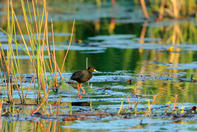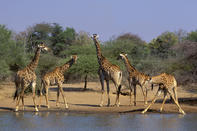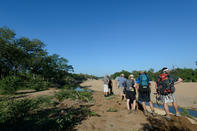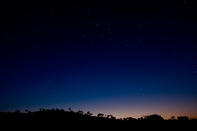Enjoy the N’wanetsi River
East of Satara, the S100 road snakes along the N’wanetsi River towards the Lebombos, a line of low blue hills marking the border between South Africa and Mozambique.

The pop of stones beneath slow tyres, verge-scuttling francolins, blond grass, ground crickets and shongolos crossing, the flap-flap-flap and glide of ever-present hornbills. Good morning Kruger. This is a particularly fruitful route in winter when cats lie in wait for the big herds of antelope that congregate along the banks. Birding is good here too: scan the reeds of the river for crakes, sandpipers and painted snipes.
Witness the N’waswitsontso River

Some of the most attractive drives in this region are to the south of the bush camps on the S145 and S125, both of which run along the N’waswitsontso River. Try the Fairfield and Mondzweni waterholes where herds of giraffe and zebra tend to mill about. Slender and dwarf mongooses poke their noses from grassy verges, before diving for cover, only to reemerge to have another look, curiosity getting the better of them.
The pachyderms were everywhere, some of them giving our Honda a flap of the ears, shake of the head or trumpet, warning us to keep our distance. From Talamati we headed south to Lower Sabie to complete the survey of the central region. This route took us from the Orpen area’s rolling hills and denser vegetation back into the cat-friendly grasslands. Because of the flat terrain (no slopes for rivers) the rain often pools in depressions to form pans where large herds and their predators congregate.
This was classic savanna and you could be forgiven for mistaking it for the Serengeti or Masai Mara.
It’s the quintessential Africa of the storybooks: sweeping vistas, miniature giraffes like toys on the horizon and your imagination free to roam the plains. Once it has got you in its grip, the park’s exit gate becomes a much-dreaded place.
Favourite Drive

Justin Fox’s favourite drive in Central Kruger is along the Letaba River from Mingerhout Dam to Engelhard Dam on the S47, H1-6 and the S46. He has never been disappointed on this route. As the terrain hereabouts is generally stunted mopane, offering relatively few sightings, game tends to congregate along the Letaba's wide floodplain.
The drive is particularly rewarding in winter when animals tend to stick closer to water. While general game sightings are excellent all along the banks, the Matambeni Hide and Engelhard Dam wall are excellent for birding. Look out for all the herons, many plovers, storks, stilts, bee-eaters and rarer species like the black heron and collared pratincole.
Adventure on Foot

For many visitors who spend their Kruger days cooped up in a vehicle, the opportunity to get out and into the bush has great appeal. To this end, SanParks provide both bush walks and mountain biking trails in Central Kruger; Olifants Camp has even introduced a backpackers' trail.
Two armed guides accompany all groups and steer you away from any potential danger. To alight from a vehicle at sunrise and track the Big Five on foot or bicycle is a thrill not to be missed.
An Extraordinary Night Sky

Sitting around a braai fire, visitors gaze up at a night sky devoid of the interference of city lights, and try to name the stars. To make your job a little easier, Olifants Camp offers evening astronomy tours. You leave at sunset in a game drive vehicle and your ranger finds an appropriate place to set up the powerful telescope.
A short lecture and snacks are followed by the chance to view some of the more prominent celestial bodies in our galaxy. The 'piece de la resistance' is a closer look at Saturn with its rings clearly visible. The clink of fruit bats, whoops of hyenas, and cry of jackals or owl calls add spice to your viewing pleasure.
By Justin Fox There is a wide variety of accommodation in Kruger National Park options ranging from rest camps to luxury Kruger Park safari lodges....
There is a wide variety of accommodation in Kruger National Park options ranging from rest camps to luxury Kruger Park safari lodges.... Driving the length of the Kruger National Park offers some of the best wildlife viewing in Africa. The park has incredibly diverse fauna and...
Driving the length of the Kruger National Park offers some of the best wildlife viewing in Africa. The park has incredibly diverse fauna and...